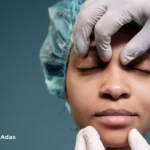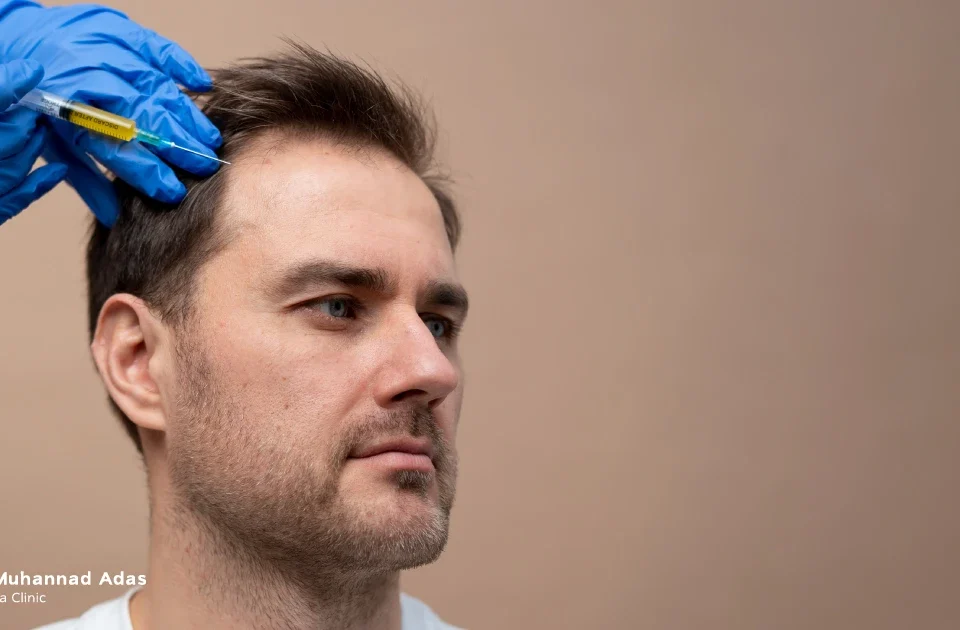Table of Contents
Hair loss is a condition that affects over 80 million individuals around the world, therefore each case is unique & different and requires several procedures to treat it. Many people, regardless of gender or age, find themselves dealing with hair loss and feeling hopeless especially when they notice an excessive amount of hair strands on their pillows, when showering or naturally without any effort.
If the hair loss persists, it is crucial to consult a specialized dermatologist that can study your condition, provide a proper diagnosis and conduct a personalized treatment plan.
Now, let’s dive a little deeper into the problem of hair loss, discussing the natural hair growth cycle, different types of hair loss, treatments, risk factors, and ways to prevent it.
How does normal hair growth occur?
Approximately 90% of hair is in a growth phase most of the time, this growth phase may vary from 2 to 6 years. During this period, about 10% of hair is at rest for a period that can possibly extend to 2-3 months, after which the hair sheds and new hair begins to grow, starting a new cycle. Typically, scalp hair grows about 10-15 millimeters per month, however this rate may gradually decrease with age.
As previously mentioned, hair loss is a natural part of the hair growth cycle. However, when does hair loss become abnormal?
Hair loss is considered excessive or abnormal when more than 100 hairs are shed per day as the normal range of hair loss is between 50 and 100 hairs daily.
Hair loss symptoms
You may notice one or more of these symptoms in hair loss and they include:
- In men their hairline recedes, while women experience the formation of bald spots between the hair.
- Hair breakage.
- Redness & swelling of the scalp.
- An itchy & burning sensation,and pain in the affected areas.
- The appearance of round or patchy bald spots on the scalp, eyebrows or beard.
- Total body hair loss due to certain health issues or medical treatments such as chemotherapy (cancer treatment).
- Sudden hair loss where a large hair strand falls when washing, brushing or even lightly pulling the hair. This condition can affect individuals who went through a traumatic emotional or physical shock.
Types of hair loss
Types of hair loss vary depending on the cause, including:
Hair loss caused by hereditary baldness
This condition is also known as male pattern baldness (androgenic alopecia). It’s the most common type of hair loss and is inherited from both the mother and the father. This issue may appear in the second, third, or fourth decades of life. Women can be affected by it if they already have thin hair, but it does not reach the stage of total baldness.
Alopecia areata
It is partial hair loss where relatively small, round, bald patches appear on the scalp with no known cause. It is, however, believed to have a link with the immune system. When immune problems occur, it may affect the hair causing Alopecia areata. This condition can affect people of various ages, including children and adults. This type of hair loss may also lead to complete hair loss on the head and body.
Telogen effluvium
Certain factors such as illness, stress, or emotional trauma can trigger this type. These factors may cause the hair to enter the resting phase of the natural hair growth cycle, leading to excessive shedding over periods of time but this issue is temporary. Surgical procedures, chronic illnesses, iron deficiency, and other conditions can also contribute to this type of hair loss.
Tinea Capitis
This condition is caused by a fungal infection of the scalp which appears as scaly patches on the scalp. These spots may continue to widen and spread and cause hair breakage, redness, and inflammation. Tinea capitis is considered contagious and it most commonly affects children but it can be treated with certain medications prescribed by a dermatologist.
Trichotillomania
Trichotillomania is a disorder where the patient has a compulsive urge to pull out their scalp hair, eyebrows or eyelashes in a harsh and strong manner. It is considered more of a bad habit rather than a health problem and a consultation is necessary to educate the patient about the harm and side effects of this phenomenon. Psychological factors such as stress or anxiety can lead to trichotillomania.
Cicatricial Alopecia
This condition is very rare and it is characterized by the development of bald, itchy and painful patches. These patches may eventually lead to scarring and hair loss. The primary cause of cicatricial alopecia is unknown, but treatments can help to prevent the spread of inflammation to other areas of the scalp.
Hair loss due to chemotherapy
When undergoing chemotherapy or radiotherapy as a cancer treatment, partial or total hair loss may occur soon after the start of the treatment.
Scalp Psoriasis
Many patients with plaque psoriasis develop psoriasis on their scalp at certain stages of the disease which can lead to hair loss.
Risk Factors
The incidence of hair loss may increase due to certain factors such as:
- Family history of the disease.
- Age of the patient.
- Drastic weight loss due to various factors.
- Certain medical cases such as diabetes and lupus.
- Constant stress and anxiety.
- Malnutrition.
Home Tests to Distinguish Between Normal and Abnormal Hair Loss
If you notice any of the previous symptoms, you can do tests at home by yourself and if the symptoms persist, you need to consult a dermatologist to find the suitable hair loss treatment:
Hair pulling test
This test is done by pulling approximately 60 strands of your hair and passing them between your fingers. If you lose about 8 strands of hair then it is normal shedding, but if you lose over 15 strands then it is considered abnormal hair loss.
Hair brushing test
Brush your hair from back to front over a white surface, if you find more than 15 hair strands then it is abnormal hair loss.
Hair loss treatment
Hair loss treatments vary from case to case based on how widespread the hair loss is and the appearance of the bald spots. These factors will help you choose a good dermatologist to satisfy your needs and give you the appropriate treatment. These treatments include:
- Mesotherapy hair injections
Mesotherapy is an advanced technique used to efficiently treat hair loss, especially when it is used in conjunction with hair plasma treatments that contain 5 times the concentration of platelets in the blood. Mesotherapy is considered one of the best treatments currently to keep the hair healthy and prevent hair loss. Other benefits of mesotherapy include:
- Fix the hormonal imbalances that occurred in the hair follicles and around them.
- Nourish the hair.
- Stimulate blood circulation in the scalp and boost its immunity.
- Manage scalp inflammation.
- Platelet rich Plasma (PRP) injections
This treatment is done by extracting a sample of the patient’s blood and processing it to concentrate the platelets rich plasma. Then, this concentration is injected back into the scalp. This procedure is considered natural and effective in promoting hair growth, therefore increasing hair density and health.
- Xeomin Hair Treatment
It is one of the most advanced techniques for effectively treating hair loss, restoring its shine, and promoting its health. This is due the natural presence of exosomes in the human body and their regenerative properties, and boosting the body’s immune response.
Exosomes are small sized vesicles, ranging in diameter from 30 to 200 nanometers. They are formed outside the cell and play an important role in cellular communication and homeostasis. These exosomes are extracted from either blood cells or adipose tissue, then they are injected into the skin to stimulate natural regeneration processes and enhance the human body’s immune response. They are also one of the best procedures that do not involve surgery to restore skin softness and youth. Additionally, they are also beneficial in:
- Promotion of hair follicle growth: These vesicles contain growth factors and other components that promote the growth of the hair follicles.
- Stimulation of blood vessel formation: They promote the growth of new blood vessels, which nourishes the hair follicle.
- Improving the hair growth cycle: They promote new hair growth as well as preventing hair loss.
- Treat inflammation: The exosomes components help reduce inflammation in the scalp.
- Surgery to restore the missing hair parts
Specialized surgeons may perform various surgical procedures to restore the missing hair and repair the areas of hair loss. This choice is suitable for individuals with visible baldness or have very thin hair or suffer from hair loss due to scalp injury or burns.
- Hair transplant
Some cases may require hair transplant especially if medical treatments and other solutions for hair loss have failed. Therefore, hair transplant surgery is the best option for these situations. The most suitable candidates for hair transplant surgery are men who suffer from male pattern baldness or women with very fine and thin hair. In addition to those who lost their hair due to injury or burns.
- Other treatments
Other treatments for hair loss include immunotherapy, where a chemical substance is applied on the bald spots or ultraviolet light therapy, or surgery to either reduce or expand the scalp depending on the individual’s case. Combined therapy may be beneficial in some cases and that is by utilizing more than one treatment technique over varying periods of time that may take up to multiple months, and in certain cases a few years.
How to prevent hair loss
It is best to implement certain preventative measures to avoid hair loss and these include:
- Choose the most appropriate and suitable products for your hair type.
- Treat your hair gently especially when it is wet while you’re drying it using a hair towel or when you’re brushing it.
- Avoid hot water showers especially on the hair.
- Massage your scalp gently in a constant manner to stimulate blood circulation in it.
- Consume a healthy diet rich in fibers, protein and other beneficial nutrients.
- Consult a doctor to take the suitable medications and supplements.
- Protect your hair and scalp from harmful sun rays.
- Quit smoking.
We have answered the most frequently asked questions that many individuals wonder regarding hair loss, if you have any other inquiries, we are more than glad to help. Contact us through the clinic’s number:
If you are suffering from hair loss or from any of the previously mentioned types of it, do not hesitate to contact the best dermatologist to choose the appropriate treatment plan for your condition. You can visit our clinic or book a consultation through the provided number. Do not forget to visit our website dradas.com and read the most recent articles in the dermatology field and to find the best cosmetic techniques.






